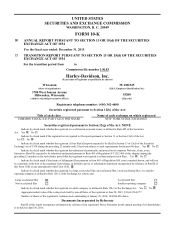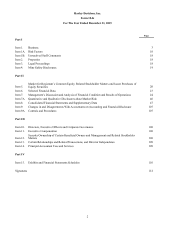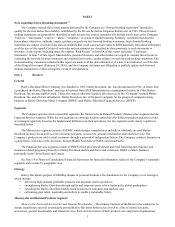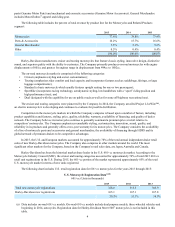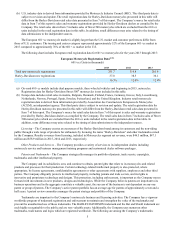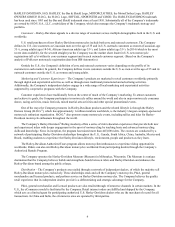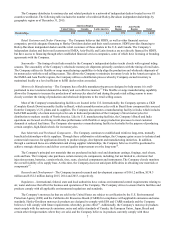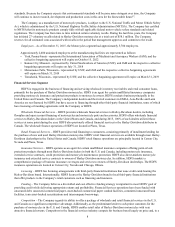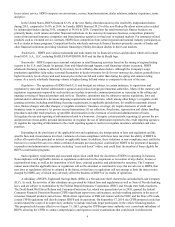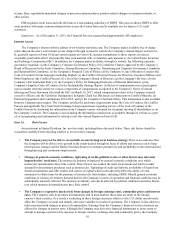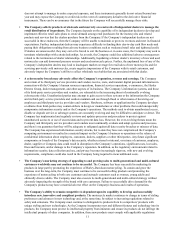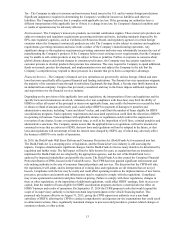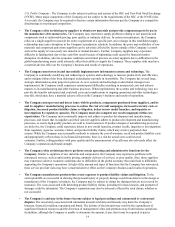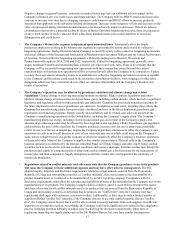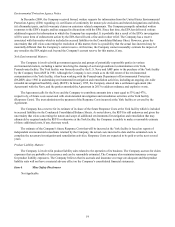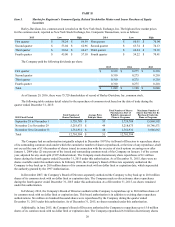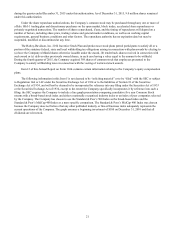Harley Davidson 2015 Annual Report Download - page 11
Download and view the complete annual report
Please find page 11 of the 2015 Harley Davidson annual report below. You can navigate through the pages in the report by either clicking on the pages listed below, or by using the keyword search tool below to find specific information within the annual report.11
does not attempt to manage its entire expected exposure, and these instruments generally do not extend beyond one
year and may expose the Company to credit risk in the event of counterparty default to the derivative financial
instruments. There can be no assurance that in the future the Company will successfully manage these risks.
• The Company sells its products at wholesale and must rely on a network of independent dealers to manage the
retail distribution of its products. The Company depends on the capability of its independent dealers to develop and
implement effective retail sales plans to create demand among retail purchasers for the motorcycles and related
products and services that the dealers purchase from the Company. If the Company’s independent dealers are not
successful in these endeavors, then the Company will be unable to maintain or grow its revenues and meet its financial
expectations. Further, independent dealers may experience difficulty in funding their day-to-day cash flow needs and
paying their obligations resulting from adverse business conditions such as weakened retail sales and tightened credit.
If dealers are unsuccessful, they may exit or be forced to exit the business or, in some cases, the Company may seek to
terminate relationships with certain dealerships. As a result, the Company could face additional adverse consequences
related to the termination of dealer relationships. Additionally, liquidating a former dealer’s inventory of new and used
motorcycles can add downward pressure on new and used motorcycle prices. Further, the unplanned loss of any of the
Company’s independent dealers may lead to inadequate market coverage for retail sales of new motorcycles and for
servicing previously sold motorcycles, create negative impressions of the Company with its retail customers, and
adversely impact the Company’s ability to collect wholesale receivables that are associated with that dealer.
• A cybersecurity breach may adversely affect the Company’s reputation, revenue and earnings. The Company
and certain of its third-party service providers and vendors receive, store, and transmit digital personal information in
connection with the Company’s human resources operations, financial services operations, e-commerce, the Harley
Owners Group, dealer management, and other aspects of its business. The Company’s information systems, and those
of its third-party service providers and vendors, are vulnerable to the increasing threat of continually evolving
cybersecurity risks. Unauthorized parties may attempt to gain access to these systems or the information the Company
and its third-party service providers and vendors maintain and use through fraud or other means of deceiving our
employees and third-party service providers and vendors. Hardware, software or applications the Company develops
or obtains from third-parties may contain defects in design or manufacture or other problems that could unexpectedly
compromise information security and/or the Company’s operations. The methods used to obtain unauthorized access,
disable or degrade service or sabotage systems are constantly evolving and may be difficult to anticipate or detect. The
Company has implemented and regularly reviews and updates processes and procedures to protect against
unauthorized access to or use of secured data and to prevent data loss. However, the ever-evolving threats mean the
Company and third-party service providers and vendors must continually evaluate and adapt systems and processes,
and there is no guarantee that they will be adequate to safeguard against all data security breaches or misuses of data.
The Company has experienced information security attacks, but to date they have not compromised the Company’s
computing environment or resulted in a material impact on the Company’s business or operations or the release of
confidential information about employees, customers, dealers, suppliers or other third parties. Any future significant
compromise or breach of the Company’s data security, whether external or internal, or misuse of customer, employee,
dealer, supplier or Company data could result in disruption to the Company’s operations, significant costs, lost sales,
fines and lawsuits, and/or damage to the Company’s reputation. In addition, as the regulatory environment related to
information security, data collection and use, and privacy becomes increasingly rigorous, with new and evolving
requirements, compliance could also result in the Company being required to incur additional costs.
• The Company’s marketing strategy of appealing to and growing sales to multi-generational and multi-cultural
customers worldwide may not continue to be successful. The Company has been successful in marketing its
products in large part by promoting the experience of Harley-Davidson motorcycling. To sustain and grow the
business over the long-term, the Company must continue to be successful selling products and promoting the
experience of motorcycling to both core customers and outreach customers such as women, young adults and
ethnically diverse adults. The Company must also execute its multi-generational and multi-cultural strategy without
adversely impacting the strength of the brand with core customers. Failure to successfully drive demand for the
Company's products may have a material adverse effect on the Company's business and results of operations.
• The Company’s ability to remain competitive is dependent upon its capability to develop and successfully
introduce new, innovative and compliant products. The motorcycle market continues to change in terms of styling
preferences and advances in new technology and, at the same time, be subject to increasing regulations related to
safety and emissions. The Company must continue to distinguish its products from its competitors’ products with
unique styling and new technologies. As the Company incorporates new and different features and technology into its
products, the Company must protect its intellectual property from imitators and ensure its products do not infringe the
intellectual property of other companies. In addition, these new products must comply with applicable regulations

